Are you curious about the fascinating world of avian adaptations? Here’s your answer: 15 small birds with long beaks that captivate with their unique features.
These remarkable avian wonders span diverse ecosystems, each species wielding its elongated bill for specific purposes, from foraging to courtship displays.
Join us on a journey through wetlands, deserts, and forests as we unveil the intricate relationships between these small birds and their environments.
From the Long-billed Dowitcher’s migratory elegance to the Carolina Wren’s melodious tunes, discover the vital roles these birds play in maintaining ecological balance.
This exploration sheds light on these feathered companions’ beauty, diversity, and significance, showcasing nature’s ingenious design in adapting to various habitats.
15 Small Birds with Long Beaks
Here is the intriguing world of 15 small birds with long beaks, each embodying a unique blend of form and function:
1. Long-billed Dowitcher
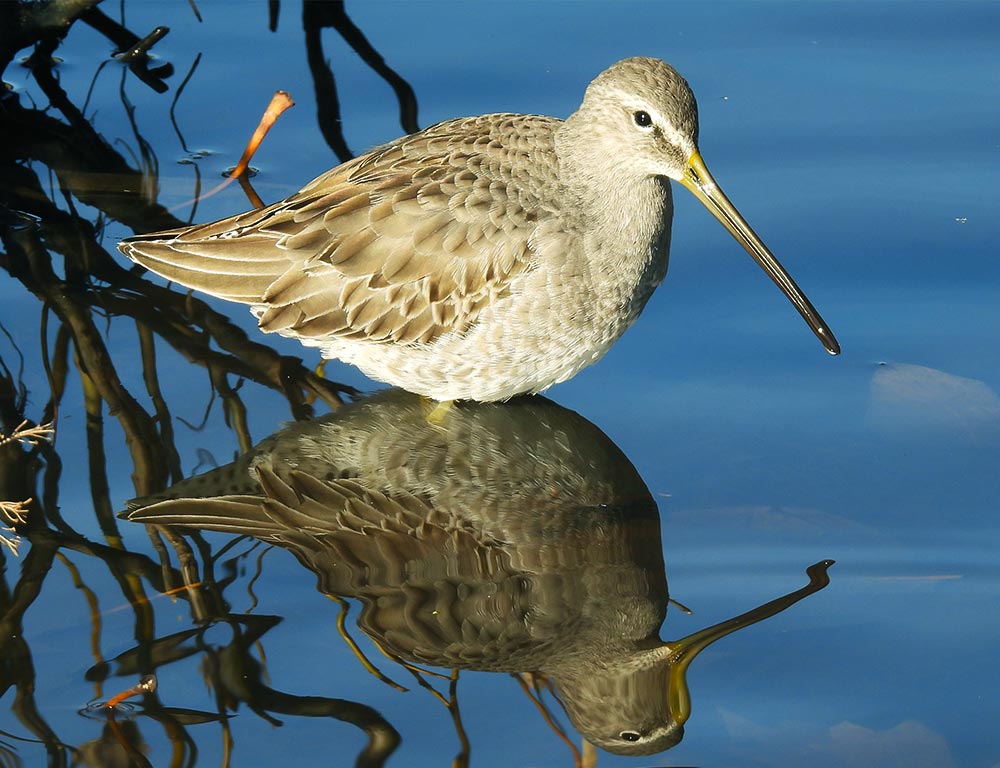
- Scientific name: Limnodromus scolopaceus
- Life span: 5-10 years
- Size: 10-12 inches
- Weight: 2.5-4 ounces
- Food: Insects, small invertebrates, and crustaceans
- Wingspan: 20-24 inches
- Status: Least Concern
The Long-billed Dowitcher is a migratory shorebird known for its distinctive long, straight bill.
With a 5-10 year lifespan, these birds are about 10-12 inches in size and weigh between 2.5 to 4 ounces. They primarily feed on insects, small invertebrates, and crustaceans.
The Long-billed Dowitcher’s wingspan spans 20-24 inches, aiding in its impressive long-distance migrations. Currently, the species holds a status of Least Concern, indicating a relatively stable population.
Long-billed Dowitchers exhibit remarkable migratory behaviour in their lifestyle, travelling great distances between breeding and wintering grounds.
During breeding season, they nest in marshy areas, while in winter, they frequent coastal mudflats. These birds are agile foragers, probing the mud with their long bills to extract prey.
Their distinctive calls echo over wetlands as they engage in courtship displays during the breeding season, contributing to the vibrant avian tapestry of their habitats.
2. Sword-billed Hummingbird
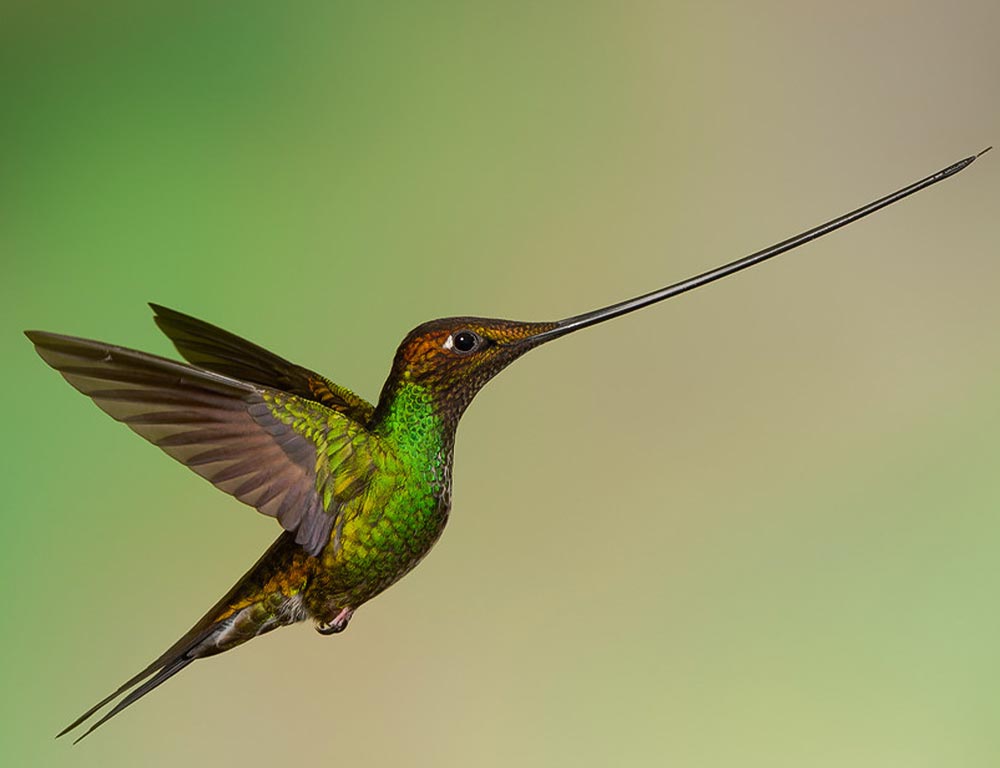
- Scientific name: Ensifera ensifera
- Life span: 3-5 years
- Size: 5-6 inches
- Weight: 10-20 grams
- Food: Nectar from long-tubed flowers
- Wingspan: 5-6 inches
- Status: Least Concern
The Sword-billed Hummingbird is a unique and visually striking species characterized by its remarkably long, straight bill.
With a 3-5 year lifespan, these hummingbirds measure 5-6 inches and weigh between 10 and 20 grams. Their primary diet consists of nectar obtained from long-tubed flowers.
Despite their small size, their wingspan matches their length, spanning 5-6 inches. The sword-billed hummingbird is categorized as least Concerned, indicating a stable population.
In their lifestyle, Sword-billed Hummingbirds are adapted for specialized feeding on flowers with long corollas, an adaptation known as “coevolution.”
Their long bills allow them to reach the deep nectar within certain flowers, ensuring a unique ecological niche.
These hummingbirds are highly territorial, fiercely defending their feeding territories, and their vibrant plumage and aerial acrobatics make them a captivating sight in their montane habitats.
3. Black-tailed Godwit
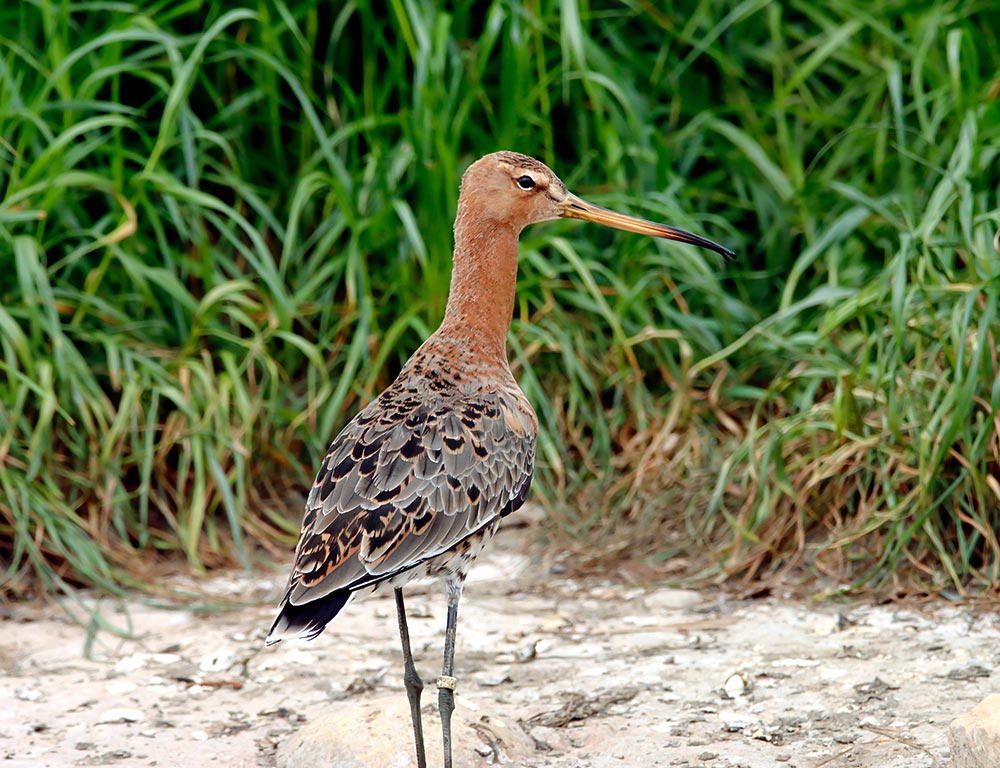
- Scientific name: Limosa limosa
- Life span: 10-15 years
- Size: 16-18 inches
- Weight: 200-400 grams
- Food: Insects, worms, and crustaceans
- Wingspan: 29-33 inches
- Status: Near Threatened
The Black-tailed Godwit is a wader bird distinguished by its long, slender bill and distinctive black-tipped tail. With a 10-15 year lifespan, these birds measure 16-18 inches and weigh between 200-400 grams.
They predominantly feed on insects, worms, and crustaceans, using their long bills to probe mud and shallow water. The Black-tailed Godwit’s wingspan ranges from 29-33 inches. Sadly, their population faces threats, earning them the status of Near Threatened.
In their lifestyle, Black-tailed Godwits are migratory birds with significant annual journeys. They breed in wetlands, forming monogamous pairs, and during migration, they cover vast distances.
These birds play a crucial role in wetland ecosystems by regulating insect populations. Conservation efforts are essential to address the threats they face, such as habitat loss and changes in land use.
4. American Woodcock
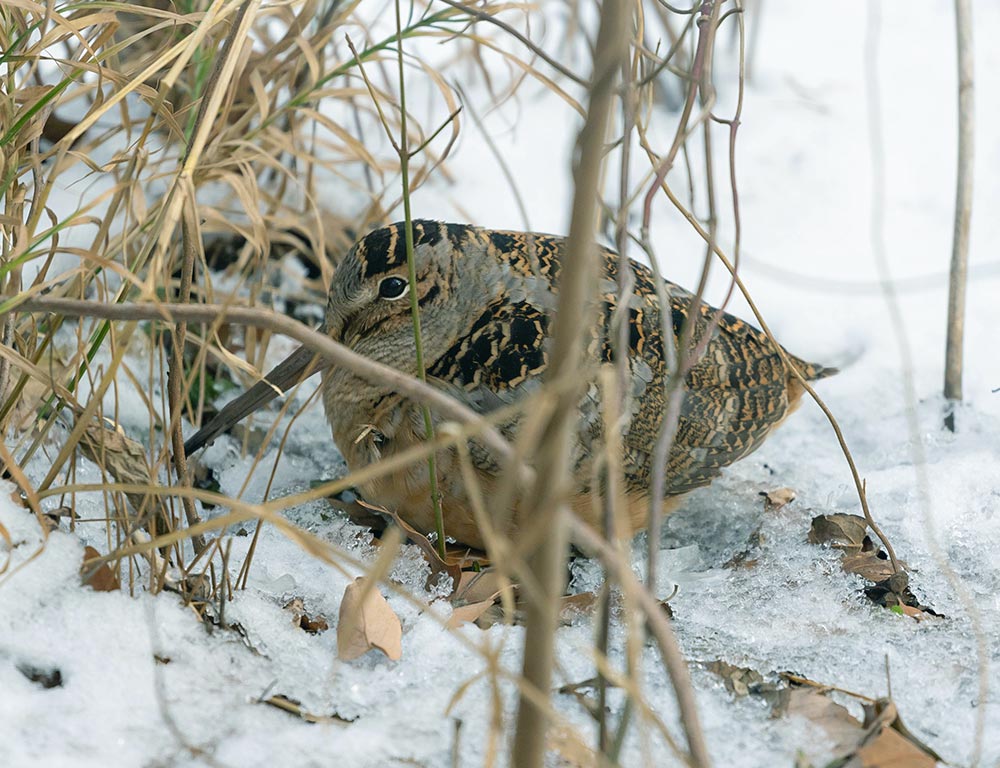
- Scientific name: Scolopax minor
- Life span: 5 years
- Size: 10-12 inches
- Weight: 5-8 ounces
- Food: Insects, earthworms, and small invertebrates
- Wingspan: 18-20 inches
- Status: Least Concern
With its long, slender bill, the American Woodcock is a distinctive woodland bird known for its unique courtship displays. With a lifespan of around 5 years, these birds measure 10-12 inches and weigh between 5-8 ounces.
They primarily feed on insects, earthworms, and small invertebrates, using their long bills to probe the soil. The wingspan of American Woodcocks ranges from 18-20 inches, contributing to their agile flight. Currently, they hold a status of Least Concern.
In their lifestyle, American Woodcocks inhabit young forests and brushy areas. During the breeding season, males perform elaborate “sky dances” to attract females, displaying their aerial acrobatics at dusk.
Their cryptic plumage provides camouflage, and their behaviour of remaining motionless helps them avoid predators. Conservation efforts focus on maintaining suitable habitats and minimizing disturbances during their critical breeding periods.
5. Bewick’s Wren
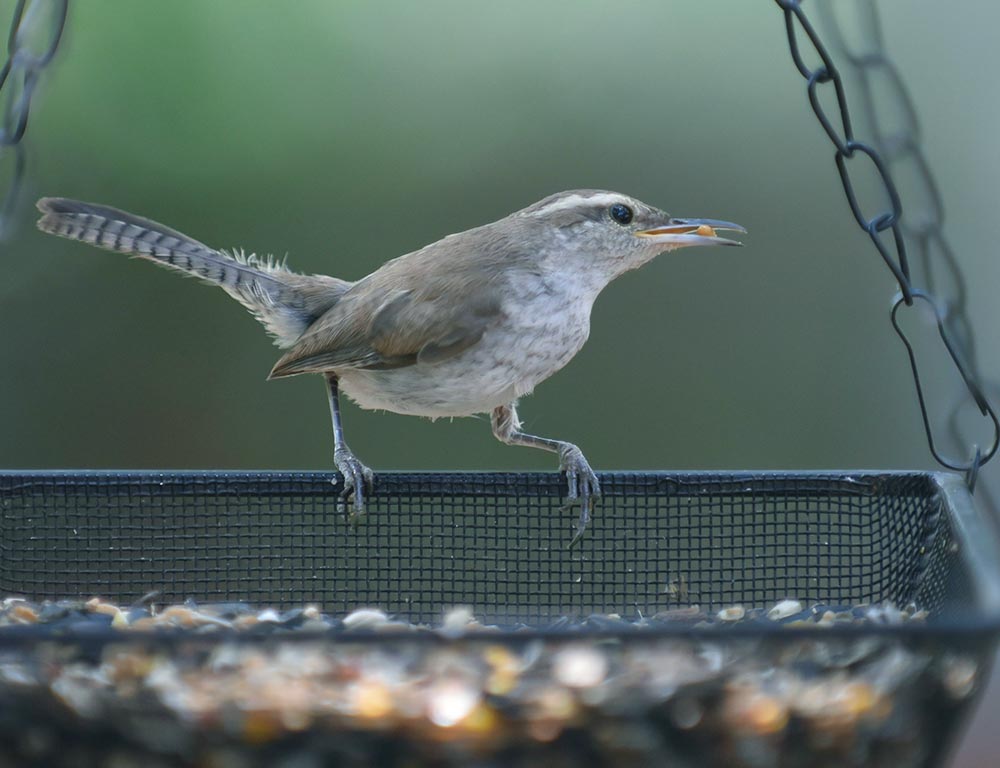
- Scientific name: Thryomanes bewickii
- Life span: 2-4 years
- Size: 5-6 inches
- Weight: 0.3-0.4 ounces
- Food: Insects, spiders, and small invertebrates
- Wingspan: 6-7 inches
- Status: Least Concern
Bewick’s Wren is a small songbird characterized by its long, slender bill and distinctive song. With a 2-4 years lifespan, these wrens measure 5-6 inches and weigh between 0.3-0.4 ounces.
Their diet consists mainly of insects, spiders, and small invertebrates, and they use their long bills to capture prey. The wingspan of Bewick’s Wren ranges from 6-7 inches.
The species is classified as Least Concern, indicating a stable population. In their lifestyle, Bewick’s Wrens are known for their energetic and agile behaviour, often foraging in dense vegetation for insects.
Their melodious songs contribute to the avian chorus of their habitats. They build cup-shaped nests in shrubs and trees, and their adaptability allows them to thrive in various wooded environments.
Conservation efforts focus on preserving diverse and suitable habitats to ensure the continued well-being of these charming songbirds.
6. House Wren
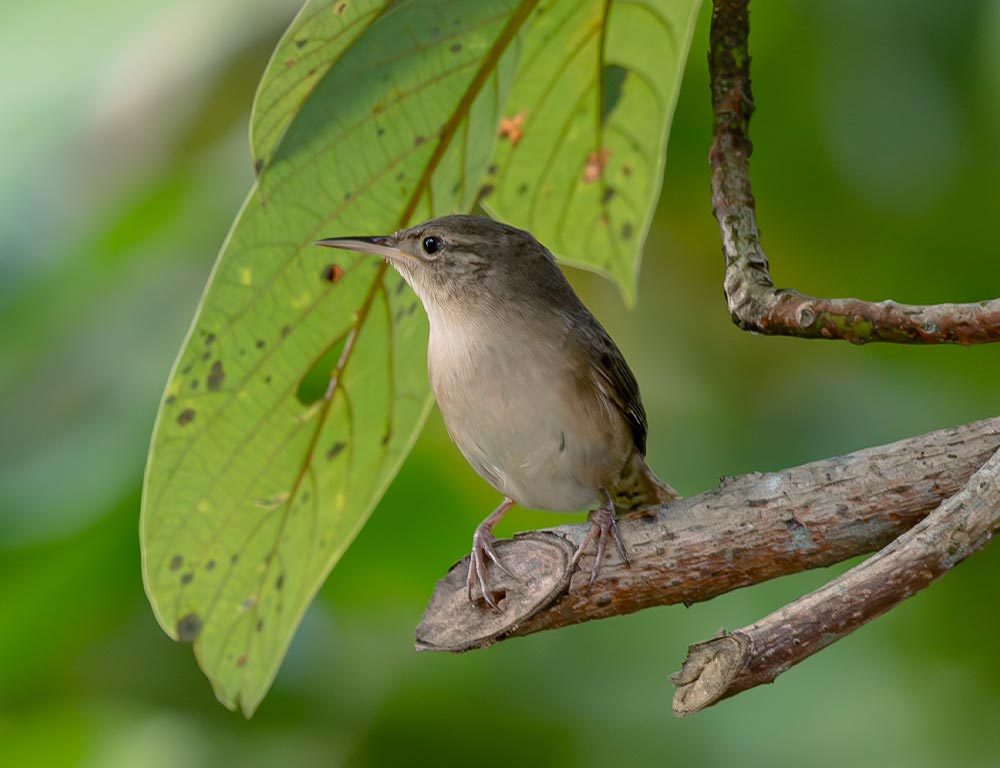
- Scientific name: Troglodytes aedon
- Life span: 2-5 years
- Size: 4.5-5 inches
- Weight: 0.3-0.4 ounces
- Food: Insects, spiders, and small invertebrates
- Wingspan: 6-7 inches
- Status: Least Concern
The House Wren is a small, energetic songbird with a short but slightly decurved bill. With a 2-5 years lifespan, these wrens measure 4.5-5 inches and weigh between 0.3-0.4 ounces.
They feed mainly on insects, spiders, and small invertebrates, utilizing their short bills for efficient foraging. The wingspan of House Wrens ranges from 6-7 inches.
The species is classified as Least Concern, signifying a stable population. In their lifestyle, House Wrens are known for their remarkable song, which serves both for territory defence and attracting mates.
They build nests in cavities, including birdhouses and natural tree hollows, often constructing multiple nests even if they use only one. Their widespread distribution across North America is attributed to their adaptability to various habitats, including suburban areas.
7. Marsh Wren

- Scientific name: Cistothorus palustris
- Life span: 2-3 years
- Size: 4.5-5 inches
- Weight: 0.3-0.5 ounces
- Food: Insects, spiders, and small invertebrates
- Wingspan: 6-8 inches
- Status: Least Concern
The Marsh Wren is a small, secretive bird with a slender, slightly downcurved bill. With a 2-3 years lifespan, these wrens measure 4.5-5 inches and weigh between 0.3-0.5 ounces.
Their diet consists mainly of insects, spiders, and small invertebrates, and they use their slender bills to navigate through marsh vegetation. Marsh Wrens’s wingspan ranges from 6-8 inches.
The species is classified as Least Concern, indicating a stable population. In their lifestyle, Marsh Wrens inhabit marshes and wetlands, where they construct globular nests attached to vegetation.
Their complex songs serve for communication and territory defence, and their ability to navigate dense vegetation makes them well-adapted to their specific habitat.
Conservation efforts often focus on preserving and restoring marsh ecosystems to ensure the survival of these wrens.
8. Winter Wren
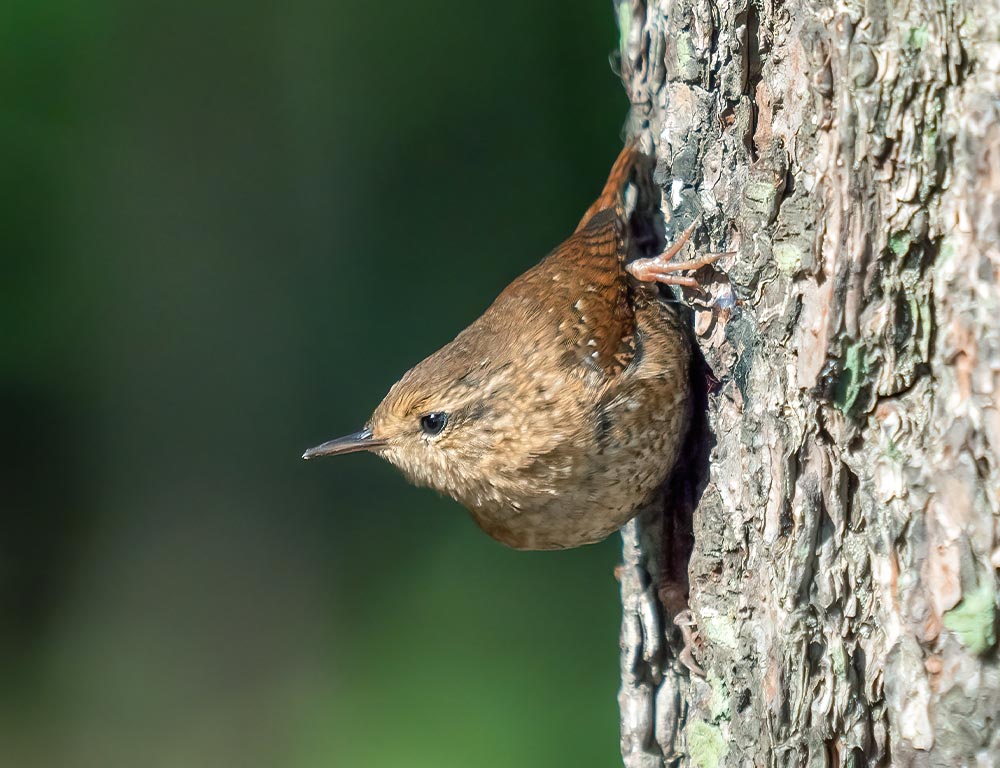
- Scientific name: Troglodytes hiemalis
- Life span: 2-5 years
- Size: 3.5-4.5 inches
- Weight: 0.2-0.4 ounces
- Food: Insects, spiders, and small invertebrates
- Wingspan: 5-6 inches
- Status: Least Concern
The Winter Wren is a small, compact bird with a short, straight bill. With a 2-5 years lifespan, these wrens measure 3.5-4.5 inches and weigh between 0.2-0.4 ounces.
Their diet consists mainly of insects, spiders, and small invertebrates, and they use their short bills for precise foraging. The wingspan of Winter Wrens ranges from 5-6 inches. Currently, the species is classified as Least Concern, indicating a stable population.
In their lifestyle, Winter Wrens are known for their vibrant and melodious songs, often heard in dense forest undergrowth. They build dome-shaped nests on or near the ground, utilizing natural cavities or thick vegetation for shelter.
These highly territorial wrens may engage in aggressive encounters with neighbouring individuals during the breeding season.
9. Carolina Wren
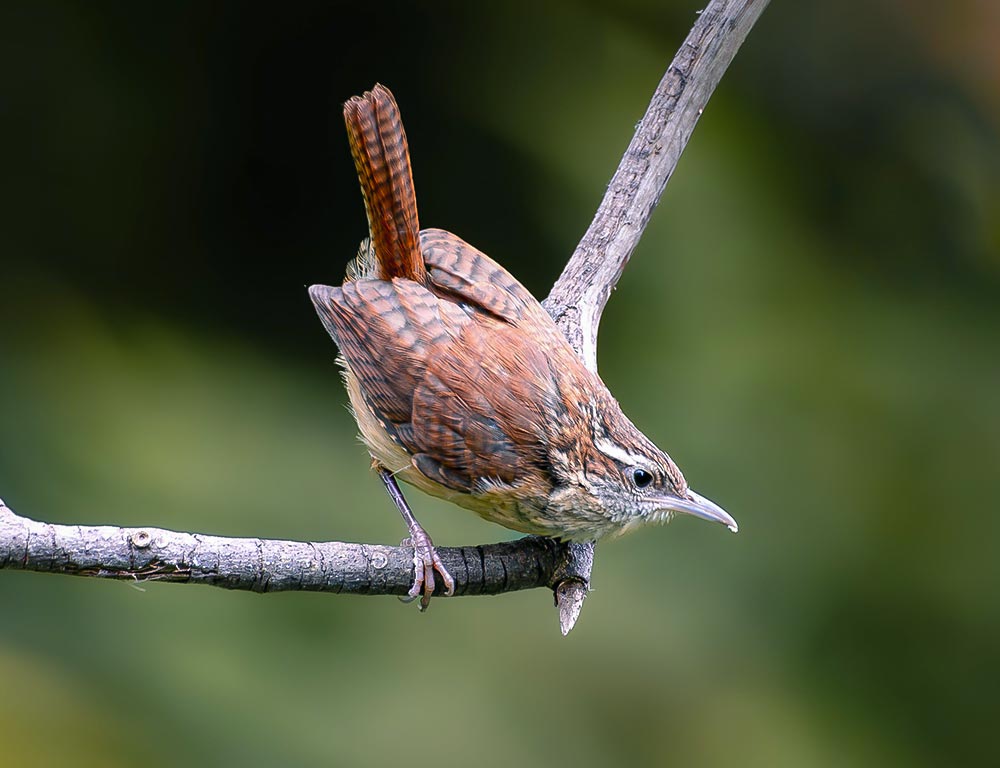
- Scientific name: Thryothorus ludovicianus
- Life span: 6-7 years
- Size: 5.5-6 inches
- Weight: 0.6-0.8 ounces
- Food: Insects, spiders, and small fruits
- Wingspan: 9-11 inches
- Status: Least Concern
The Carolina Wren is a medium-sized wren with a slightly curved bill. With a 6-7 year lifespan, these wrens measure 5.5-6 inches and weigh between 0.6-0.8 ounces.
Their diet includes insects, spiders, and small fruits, and they use their moderately curved bills for efficient foraging. Carolina Wrens’ wingspan ranges from 9 to 11 inches. The species is classified as Least Concern, indicating a stable population.
In their lifestyle, Carolina Wrens are known for their loud and melodious songs, often heard throughout the year. They build cup-shaped nests in various locations, including shrubs, tree branches, and even flowerpots.
These adaptable birds are commonly found in various habitats, including gardens, forests, and suburban areas. Their lively presence and vocalizations make them a beloved sight for birdwatchers.
10. Sedge Wren
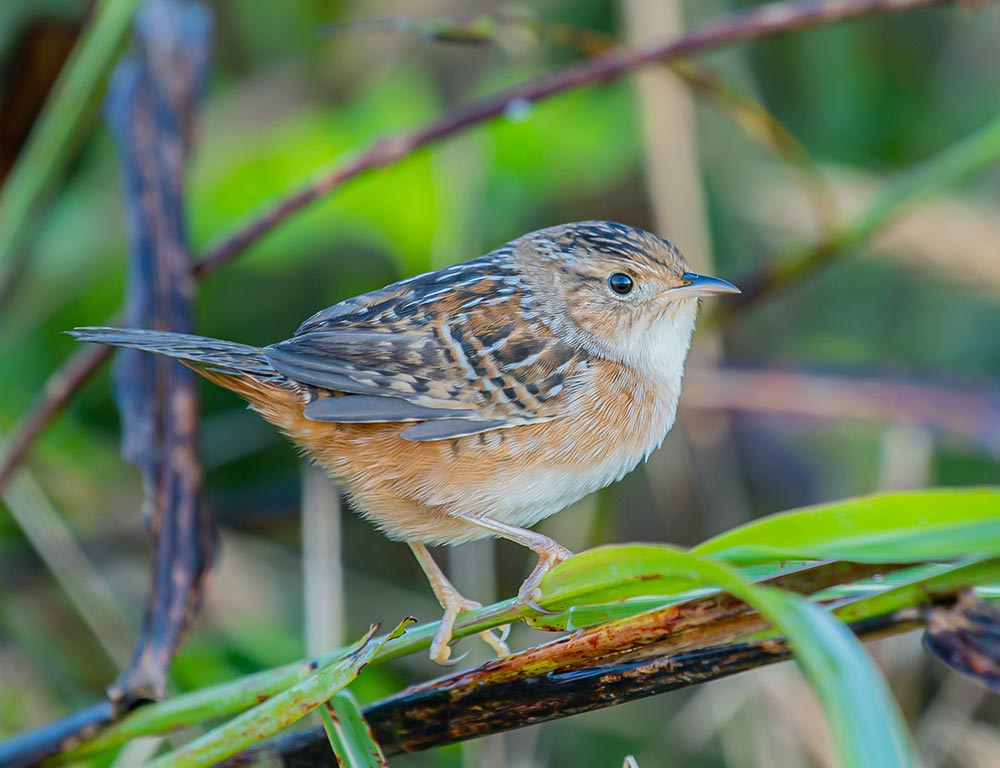
- Scientific name: Cistothorus platensis
- Life span: 1-2 years
- Size: 4-5 inches
- Weight: 0.3-0.4 ounces
- Food: Insects, spiders, and small invertebrates
- Wingspan: 6-7 inches
- Status: Near Threatened
The Sedge Wren is a small, secretive bird with a slender, straight bill. With a relatively short lifespan of 1-2 years, these wrens measure 4-5 inches and weigh between 0.3-0.4 ounces.
They primarily feed on insects, spiders, and small invertebrates, using their slender bills to navigate through dense vegetation. The wingspan of Sedge Wrens ranges from 6-7 inches.
Unfortunately, the species is classified as Near Threatened due to habitat loss and degradation. Sedge Wrens inhabit wetlands and grassy areas in their lifestyle, constructing cup-shaped nests within dense vegetation.
Their songs are often described as a series of trills, and they play a crucial role in ecosystem dynamics by controlling insect populations.
Conservation efforts focus on preserving and restoring suitable habitats to ensure the survival of these wrens facing threats from agricultural intensification and land development.
11. Cactus Wren
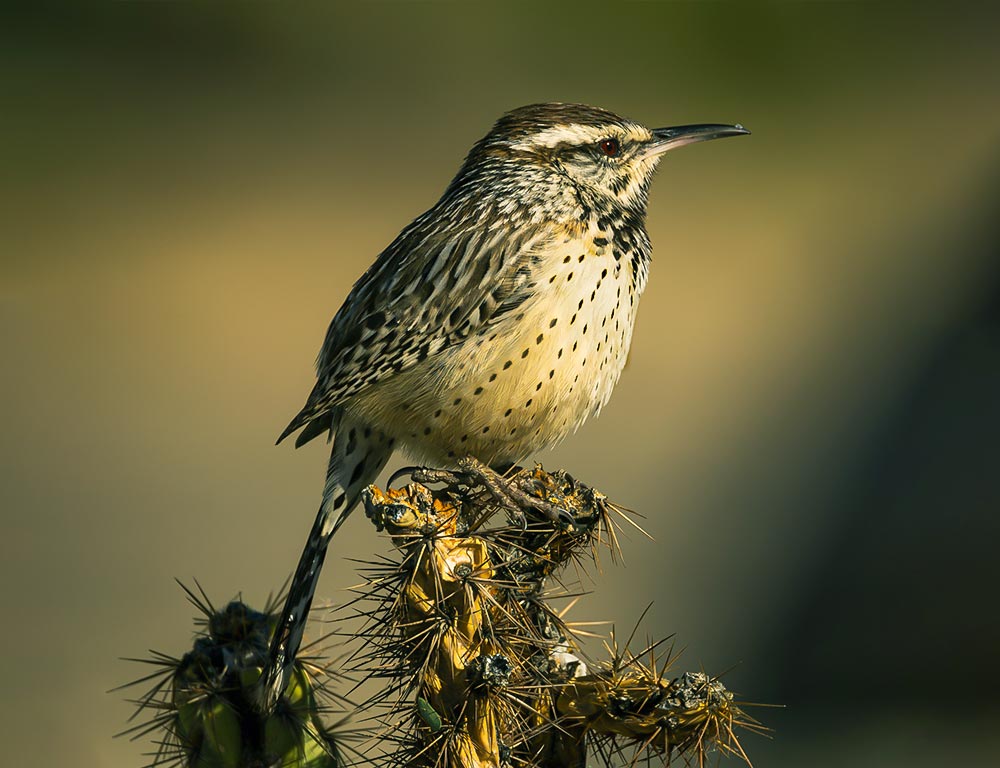
- Scientific name: Campylorhynchus brunneicapillus
- Life span: 5-7 years
- Size: 7-9 inches
- Weight: 1-2 ounces
- Food: Insects, spiders, seeds, and fruits
- Wingspan: 12-15 inches
- Status: Least Concern
The Cactus Wren is a distinctive bird with bold white stripes on its face and a slightly curved bill. With a 5-7 year lifespan, these wrens measure 7-9 inches and weigh between 1-2 ounces.
Their diet includes insects, spiders, seeds, and fruits, and they use their sturdy bills for foraging in arid environments.
The wingspan of Cactus Wrens ranges from 12-15 inches. The species is classified as Least Concern, indicating a stable population.
In their lifestyle, Cactus Wrens are well-adapted to desert habitats, building globe-shaped nests in cacti for protection against predators. Their melodious songs are often heard echoing through the arid landscapes.
These wrens are highly territorial and engage in elaborate displays during the breeding season. Conservation efforts focus on preserving their unique habitats and addressing potential threats from urbanization and habitat destruction.
12. Cerulean Kingfisher
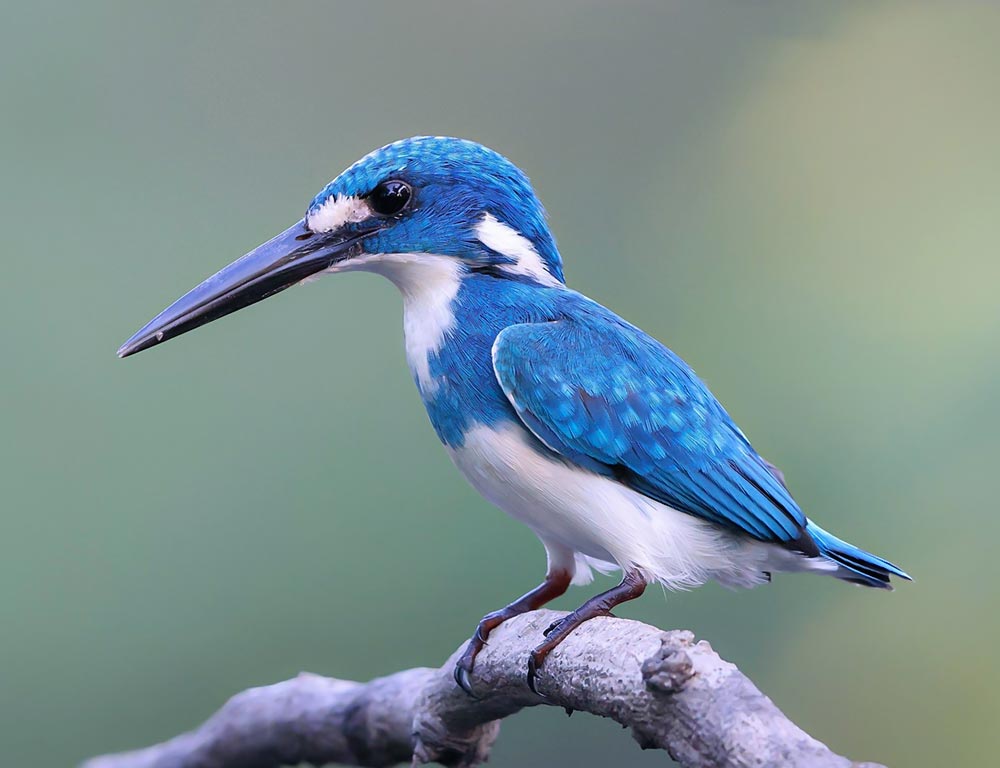
- Scientific name: Todiramphus lazuli
- Life span: Information not well-documented
- Size: 8-10 inches
- Weight: Information not well-documented
- Food: Fish, insects, and aquatic invertebrates
- Wingspan: Information not well-documented
- Status: Near Threatened
The Cerulean Kingfisher is a stunning bird with vibrant blue plumage and a long, straight bill. Information about its lifespan, size, weight, wingspan, and status is not well-documented.
These kingfishers primarily feed on fish, insects, and aquatic invertebrates, using their bills for precise strikes while perched near water bodies. Unfortunately, the Cerulean Kingfisher is classified as Near Threatened due to habitat loss and degradation.
In their lifestyle, Cerulean Kingfishers inhabit riverbanks and coastal areas, where they nest in tree cavities. Their striking appearance and unique foraging behavior make them a target for birdwatchers and photographers.
Conservation efforts focus on preserving their riparian habitats, addressing threats such as deforestation and pollution, and ensuring sustainable management of their ecosystems.
13. Keel-billed Toucan
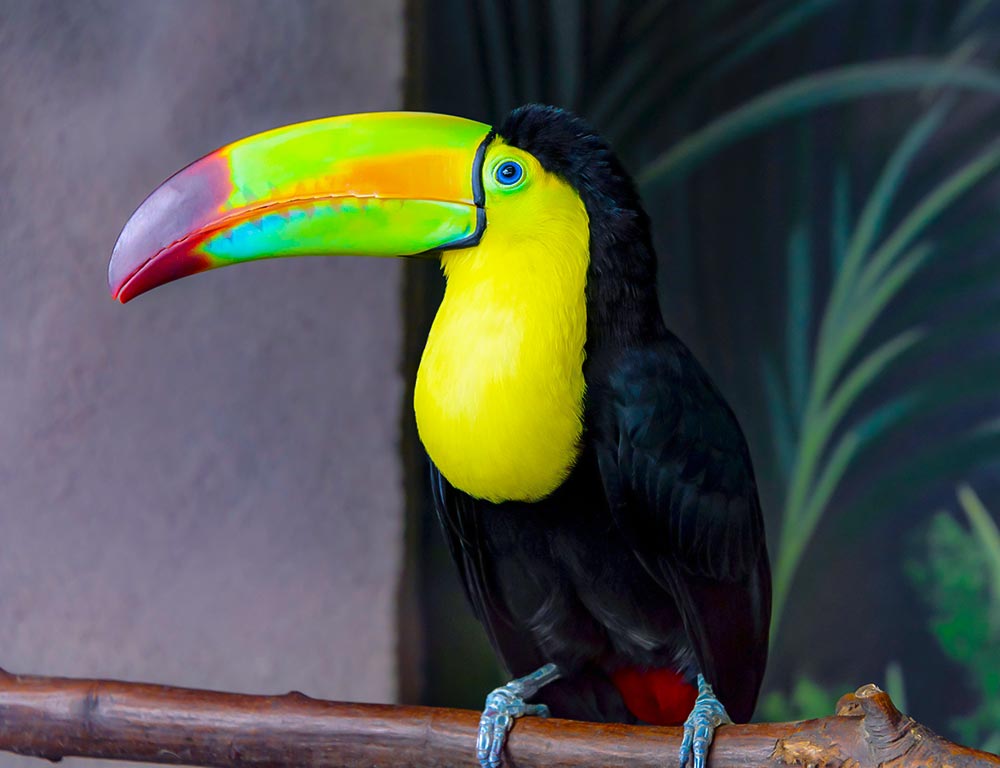
- Scientific name: Ramphastos sulfuratus
- Life span: 15-20 years
- Size: 17-22 inches
- Weight: 4-7 ounces
- Food: Fruits, insects, and small vertebrates
- Wingspan: 20-22 inches
- Status: Least Concern
The Keel-billed Toucan is a colourful bird with a large, vibrant bill and a striking rainbow-like appearance. With a 15-20 year lifespan, these toucans measure 17-22 inches and weigh between 4-7 ounces.
They feed on a diet of fruits, insects, and small vertebrates, using their large bills for reaching and manipulating food. The wingspan of Keel-billed Toucans ranges from 20-22 inches. The species is classified as Least Concern, indicating a stable population.
In their lifestyle, Keel-billed Toucans are found in tropical forests, which play a crucial role in seed dispersal. Their distinctive calls and social behaviour make them a charismatic species.
They nest in tree cavities and are known for their playful interactions. Conservation efforts focus on preserving their forest habitats and addressing potential threats from habitat fragmentation and illegal pet trade.
14. Canyon Wren
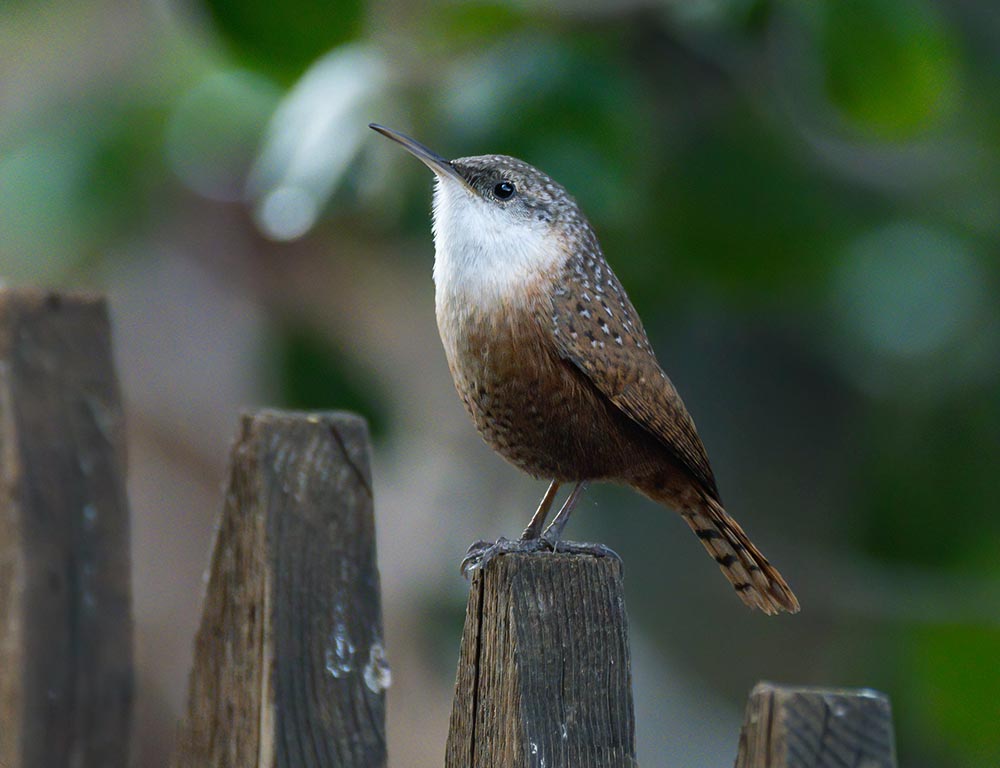
- Scientific name: Catherpes mexicanus
- Life span: 5-7 years
- Size: 4.5-5 inches
- Weight: 0.4-0.6 ounces
- Food: Insects, spiders, and small invertebrates
- Wingspan: 7-9 inches
- Status: Least Concern
The Canyon Wren is a small, cryptic bird with a slender, slightly curved bill. With a 5-7 years lifespan, these wrens measure 4.5-5 inches and weigh between 0.4-0.6 ounces.
They primarily feed on insects, spiders, and small invertebrates, using their bills for precise foraging along rocky canyon walls. The wingspan of Canyon Wrens ranges from 7-9 inches. Currently, the species is classified as Least Concern, indicating a stable population.
In their lifestyle, Canyon Wrens are well-adapted to arid environments, nesting in crevices and rocky ledges. Their cascading songs reverberate through the canyons, contributing to the auditory landscape of their habitats.
Conservation efforts focus on preserving their rocky habitats and addressing potential threats from habitat disturbance and climate change.
15. New Zealand Kiwi
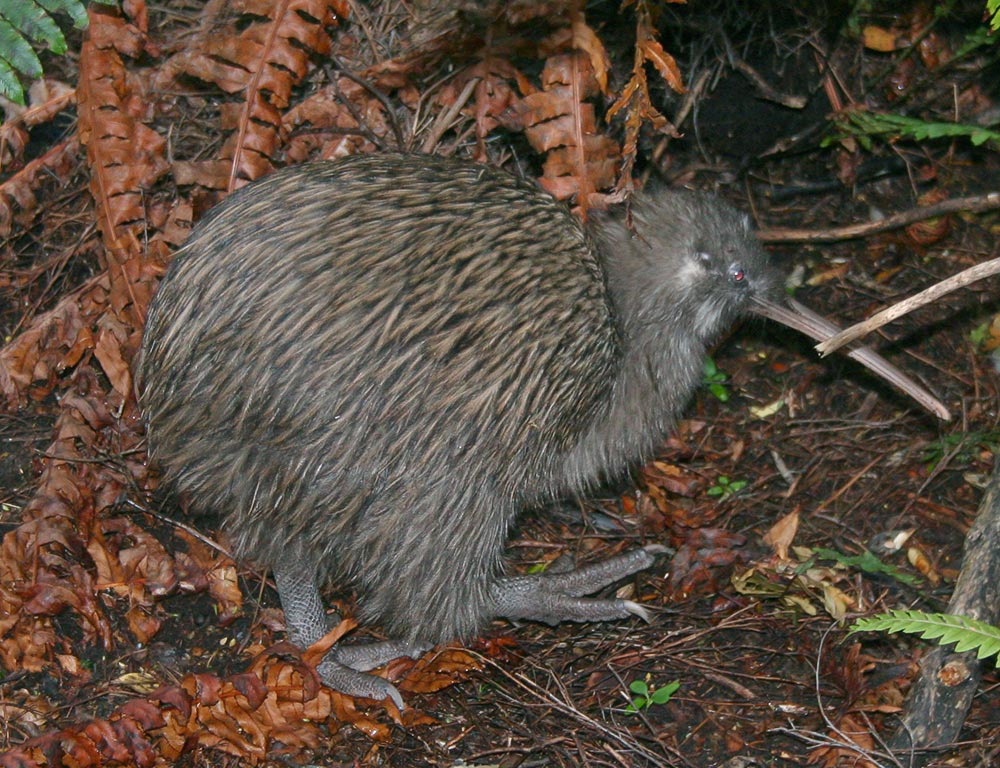
- Scientific name: Apteryx species (several species exist)
- Life span: 25-50 years (depending on the species)
- Size: 16-20 inches
- Weight: 2-9 pounds (depending on the species)
- Food: Insects, worms, and fruits
- Wingspan: Absent (flightless)
- Status: Vulnerable to Endangered (depending on the species)
The New Zealand Kiwi refers to several flightless bird species, including the North Island Kiwi and South Island Kiwi. They have small, stout bills and distinctive, bristle-like feathers.
Depending on the species, their lifespan ranges from 25-50 years, and they vary in size and weight. Kiwis primarily feed on insects, worms, and fruits, using their long bills to probe the forest floor. Kiwis are flightless, and they lack a wingspan.
The conservation status varies among species, some vulnerable to Endangerment due to habitat loss, introduced predators, and other threats. In their lifestyle, Kiwis are nocturnal and have a keen sense of smell, which helps them locate food in the dark.
They nest in burrows and are known for their shy and elusive behaviour. Conservation efforts focus on predator control, habitat restoration, and captive breeding programs to safeguard these unique and iconic New Zealand birds.
Wrapping Up
The diverse world of small birds with long beaks showcases nature’s ingenuity in adaptation and survival.
From the Long-billed Dowitcher’s migratory prowess to the Carolina Wren’s vibrant melodies, each species thrives in specific environments, utilizing their specialized bills for foraging and courtship.
These birds play crucial roles in ecosystem dynamics, contributing to insect control, seed dispersal, and maintaining ecological balance.
Exploring the lifestyles of these avian wonders reveals the intricate relationships between form and function, with each species finely tuned to its habitat.
Whether navigating wetlands, deserts, or dense forests, these birds exemplify the remarkable diversity of avian life.
Conservation efforts become paramount to ensure the continued well-being of these species, addressing threats such as habitat loss, climate change, and human disturbances.